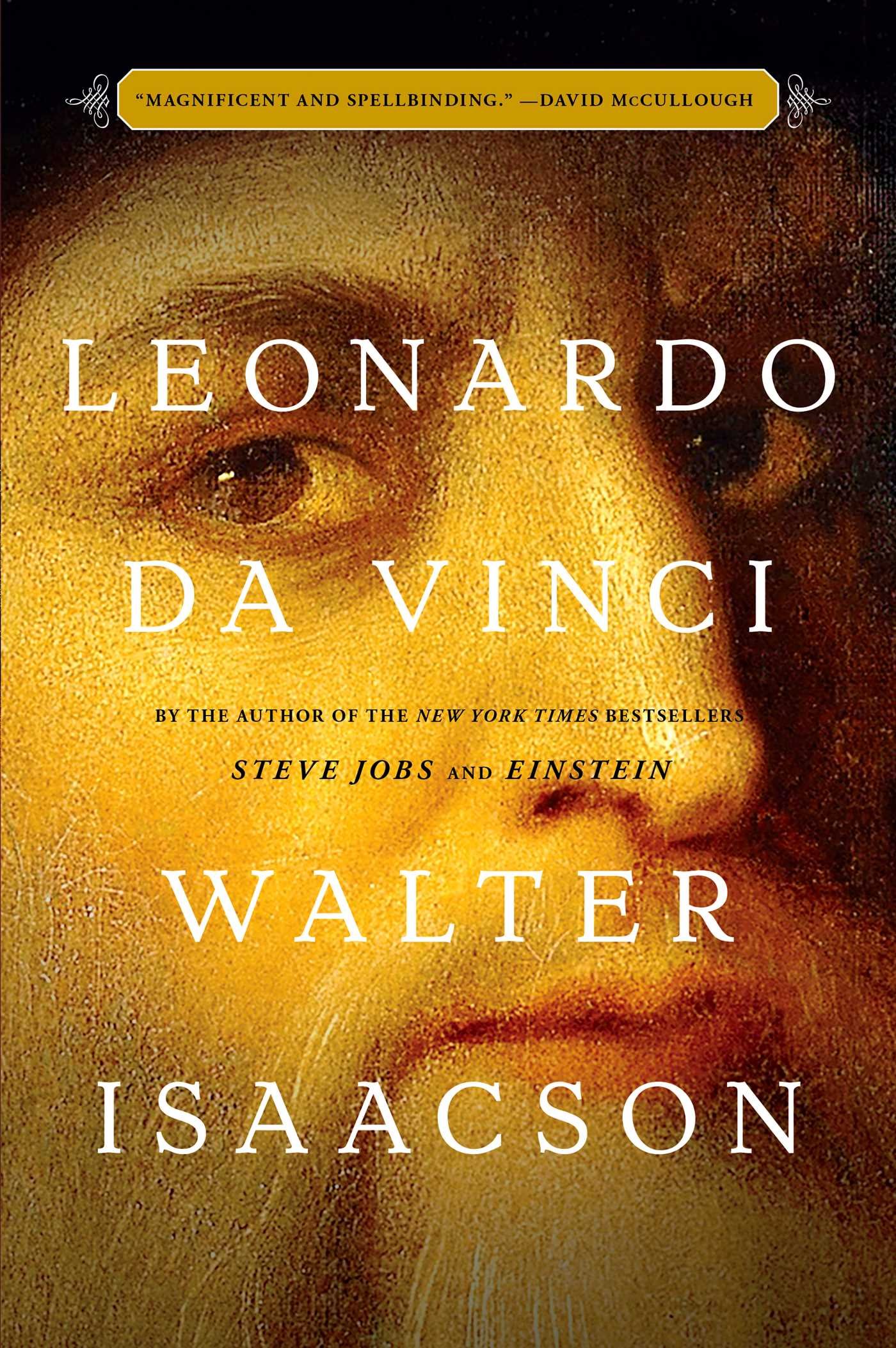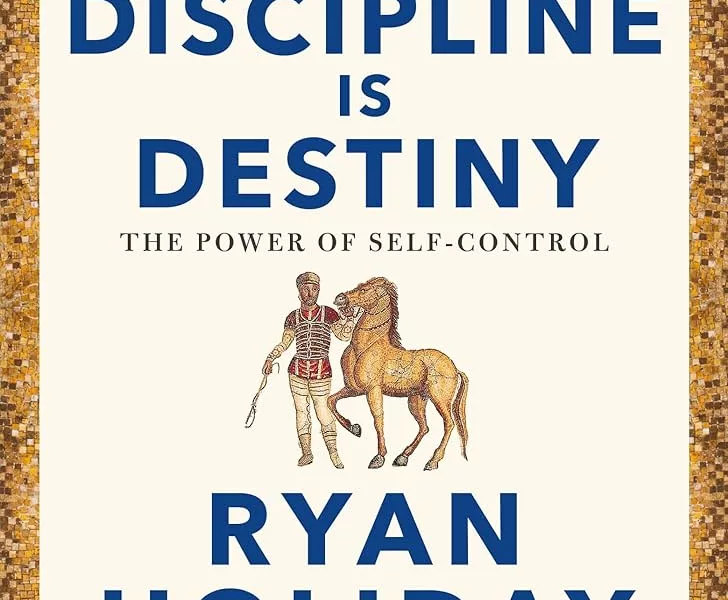Leonardo da Vinci by Walter Isaacson is a fascinating read for anyone interested in learning more about the great Leonardo da Vinci. Although this book is hefty at 525 pages (excluding the notes, works cited, and index), the story of Leonardo is so captivating that you blow right through the book!
Pairs With: a homemade chocolate cake. After all, baking is an art and a science and are two of Leonardo’s favorite things to combine!
Overview
Leonardo da Vinci by Walter Isaacson lives up to the hype. Although this book may seem large and intimidating, the story of Leonardo is so captivating that you blow right through the book! Isaacson does a great job of showing who da Vinci was as a person along with who he was as a painter, scientist, inventor, and thinker. He breaks down the mystery of da Vinci’s mind by deciphering Leonardo’s paintings, notebooks, and recorded interactions. Isaacson provides anecdotes that bring da Vinci to life and make him a relatable person. After reading Leonardo da Vinci you will see him as a curious man with many talents. You’ll also see him as a normal person who got distracted or bored and who lived his life doing what he wanted.
When a well-known wealthy patron asked da Vinci to do a self-portrait of her but he wasn’t interested – he made up excuses and bought time to avoid doing it. He didn’t seem to care who she was, he was not interested in the money or fame associated with it. And when the Florentine statesman, Piero Soderini, pitted Leonardo and Michelangelo against each other, da Vinci walked away from the painting and never looked back. (For the record, Michelangelo didn’t finish his either. It’s almost like if you take the fun out of a task, people don’t want to work for you haha.)
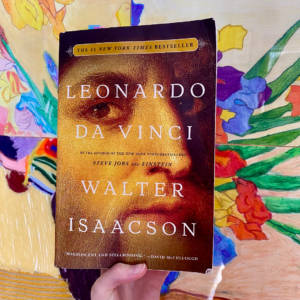
To Be the Unknown First
This book is filled with “did you know da Vinci was actually the first to discover ____ but never published his findings??”
For example, Leonardo was the first to:
- Discover that water erodes the land and creates valleys. Da Vinci noticed, “the strata on one side of the river corresponding with those of the other” (p. 439). This discovery wouldn’t be made official for another 200 years.
- Discover the way the aortic valve works in the heart. Da Vinci’s discovery was based on what he had observed with water eddies, wind currents and hair curls. It would be another 450 years (not until the 1960s) that his aortic valve findings were rediscovered (p. 416).
- Create a detailed aerial view for a map with 8 directions (N, S, E, W, NE, NW, SE, and SW) and specific colors to indicate water, buildings and roads. He also included distances after creating and perfecting his own odometer (p. 342).
- Draw 3D polyhedrons and was “among the first to deconstruct complex mechanisms and make separate drawings of each element” (p. 344). Think of the blown apart drawings you see when assembling your iKea furniture, Leonardo was one of the first to do that.
- Fully describe the human teeth and roots. He observed that a typical human has 32 teeth and “the six upper molars have three roots each, of which two roots are on the outer side of the jaw and one on the inner” (p. 216). Isaacson points out that if there weren’t so many other things to remember Leonardo for, he “could have been celebrated as a pioneer of dentistry.”
- Discover the laws of friction. However, it would be about 200 years until a French scientist, Guillaume Amontons, would rediscover these laws and publish the findings.
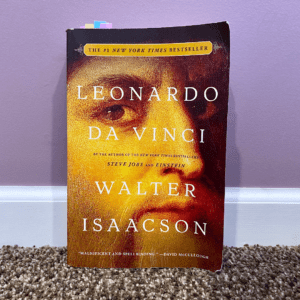
Understanding Great Works of Art
Maybe you’re not like me and you can look at a piece of art and appreciate EVERYTHING that the artist was conveying. I’m not that good (although I’d love to be). Isaacson helps the reader appreciate da Vinci’s works on a deeper level by breaking down each piece.
Although I’m not religious, The Last Supper has become my favorite of da Vinci paintings. At 15 feet high, 29 feet wide this is one of da Vinci’s largest surviving works. Thankfully this painting was saved during the bombings of WW2 by sandbags (p. 291).
Incorporating Reality
There are so many aspects of this work to love but my favorite is that da Vinci incorporated the actual room into this painting. He blended reality into this piece of art. The light in the painting appears to come from the real window in the room that is to the left of the painting.
Playing with Perspectives
Another interesting thing da Vinci did was play with lines and perspectives, which he called complex perspectives, so that the painting looked accurate from either side of the room or the middle. He thought so deeply about how his work would be viewed throughout the space and put the additional effort into making the painting special from all angles and locations. Although he had to fudge the perspective to make this work, he used various tricks to cover up the differing perspectives.
Conveying Emotion
Another great thing is how da Vinci depicts a frenzy of emotion and concern radiating out from Jesus after he states, “One of you will betray me.” We see the 12 apostles grouped in threes each responding so realistically we can almost hear their reactions. There’s relatable and realistic emotion and movement in each of the characters depicted. We see the characters are responding in a frenzy wondering who will betray him. Jesus remains calm as motion and emotion ripple out from him in groups of 3.
Appreciating Other Works of Art
This book will help you appreciate not only Leonardo da Vinci’s incredible works but also all art. I have found a new appreciation for how to view artists’ works that goes deeper than before. Now I will look at a piece and ask, “is there motion in this piece? Where is the light coming from? Are any lines crisper as a way to convey an object is closer to us? Why did they include an ermine? Did the artist dissect over 30 bodies and study the muscles that move the lips to get this smile just so? No, just Leonardo? That sounds about right.”
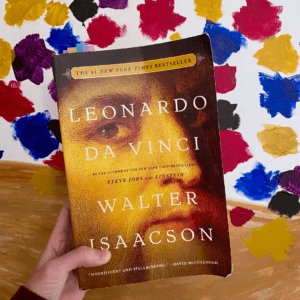
Conclusion
Walter Isaacson does a phenomenal job painting a portrait of one of the most famous painters from so long ago. It could not have been an easy task to organize and do such a great mind justice.
After finishing reading the book, you’ll feel as though you really know who da Vinci was and what made him tick. Instead of being this mysterious genius, you’ll now see him as a brilliant, observant man driven by curiosity and the desire to truly learn everything.
If you want to learn more about what makes da Vinci and his works such a force, pick up this book and prepare to be wowed.
Have you read this one or any other works on Leonardo da Vinci? What did you think? Or have you read any other books by Walter Isaacson? I really enjoyed his writing style too! Let us know in the comments below!
P.S. If you liked this one, you may also like Big Magic by Elizabeth Gilbert! It’s all about creativity and how to fearlessly live a creative life.
Thank you so much for supporting my blog! As an Amazon Associate, I earn from qualifying purchases.

